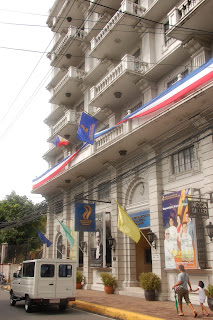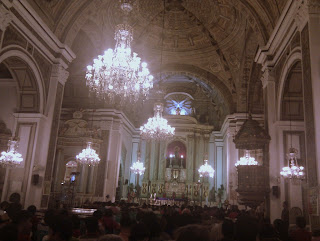View Candidate Locations for 2104 PASEA Symposium in a larger map
Last week, three of us --- Pat, Dr. Moh'd Anis Moh'd Nor (--- "Anis," an old friend of ours teaching at the University of Malaya), and Yours Truly --- set out for a quick trip to scout the venues for a possible Bali symposium location. Pat and Anis also hope to identify the key members of the local events organizing committee. As usual, Yours Truly is just tagging along for the ride --- I've never been to Bali! (Click on the photos on this page to view an enlarged version.)
We land at the Bali Int'l Airport after a three-hour flight from Kuala Lumpur. Anis breezes through immigation; his Malaysian passport lets him enter Indonesia without a visa. No such luck for Pat and me. A long line of Aussie tourists snakes before us, and a planeload of Chinese tourists is right behind us.
We finally make it through the line. Anis, bless his heart, has already retrieved our bags, and is waiting for us. We make our way out of the airport, walking past a familiar American fine dining establishment. We are headed for the parking lot to a waiting vehicle that we've hired for the next few days.
Our car is one of the smaller Toyota vans, driven by our Balinese driver Wayan. Pak (Mr.) Wayan turns out to know the area inside out. Our van can seat five passengers relatively comfortably, and up to seven tightly. (More if you push it.) Pak Wayan will be our driver for the next two and a half days.
We plunge into the extremely crowded Bali traffic going from the airport to the various tourist beaches (where most Aussies are headed) and to downtown Denpasar, the provincial capital of Bali. Our hotel is in the middle of Denpasar.
Along the way, we pass many Hindu temples. Where there would be neighborhood mosques in most of the rest of Indonesia, Bali has temples. Most Balinese practice a unique brand of Hinduism that is quite distinct from the version found in India.
One neat thing about Denpasar (and much of the rest of Bali) is that government buildings, commercial establishments, and larger private homes try to hew to the traditional Balinese-style architecture. Even this familiar foreign establishment is trying its best to fit in ...
There appears to be festivals and rituals going on at many temples in town. These Balinese ladies in traditional dress are entering a temple archway.
Bye and bye, we arrive at Hotel Puri Ayu, a 44-room hotel on Jalan Jendral Sudirman in Denpasar. This hotel has a simple but great Indonesian breakfast buffet...
Pat and Anis check us into the hotel that will be our base for our Bali stay. After a short rest, we pay a visit to Anis' friend Rucina Ballinger for dinner that night. Rucina is an American who's a renowned Balinese dancer, and author of a book on Balinese performing arts.
The next morning, we start on the business portion of this trip. The map below indicates the locations we show in the photos that follow. Click on the map markers.
View Business Trip to Denpasar, Bali, Indonesia in a larger map
Our first stop is the office of the rector (president) of the Universitas Udayana, the main university in Bali. The rector's office is in the Buikit Jimbaran campus, while the venue of interest to us is in Udayana's Sudirman campus downtown.
Today, we are accompanied by Prof. I Nyoman Darma Putra, who teaches Indonesian Literature at Udayana University. He will introduce us to the University rector, and will, if Bali is chosen, be on the local organizing committee. Pat and Prof. Dharma confer outside the university admin bldg.
We are ushered into the Rector's office. On behalf of the ICTM PASEA Study Group, Anis requests the university's participation in the 2014 symposium, if Bali is selected. The Rector notes that arts promotion is one of the university's missions, and pledges full support. He tells Prof. Dharma: "Make it so!"
Thus empowered, we travel back to Denpasar to the Sudirman campus of the unversity. This campus is only about half a kilometer from our hotel, an easy walk should we go back there in 2014. We check out the building where the auditorium sits.
The auditorium was being used, letting us see the seating and audio-visual arrangements. In ICTM Study Group symposia, all participants sit together and listen to all the talks --- there are no parallel sessions. The room must be large, well equipped, and comfortable. This facility passed with flying colors.
Then on to STIKOM, a private college specializing in IT. STIKOM sponsors many of Bali's cultural events, working with Udayana U. in many of them. Their graduates go on to universities in Malaysia and elsewhere for their degrees, both graduate and undergraduate.
We have a sumptuous Balinese seafood lunch with STIKOM's administrators. Anis and Pat explain how two of the four symposium days can be held at Udayana and the other two at STIKOM. They stress that the cost must be affordable for Indonesian graduate students from around the country to attend.
We then inspect STIKOM's large meeting room. With the proper furniture, the room should do well for the symposium sessions. The auditorium and STIKOM's entire campus are wired to the hilt for audio-visual and internet access. Pat and Anis are satisfied that both venues will do well for a Bali conference in 2014.
And just like that, the main business portion of this trip is done! It has been a very successful trip. If held in Bali, the 2014 Study Group symposium will be a blast! And now it's time to relax for the evening in a touristy setting... this is Bali, after all! We go out to dinner in the Jimbaran beach area.
The tourist dinner experience is not complete without an "authentic" Balinese dance. Watching this, Pat and Anis conceive of a 2014 conference sub-topic: "Invention and Re-invention of performing arts" (or something). This theme would include the pseudo "culture" created for the travel industry.
But enough work and academia for now! We join Aussie tourists in swilling beer and wine and soft drinks, and enjoy a relaxing meal on the beach. Tomorrow we tie up minor loose ends, and check out some possible hotels for the 2014 symposium. On the day after, we visit the town of Ubud. Stay tuned!
NEXT: A day in Ubud with Garrett Kam ...



































































